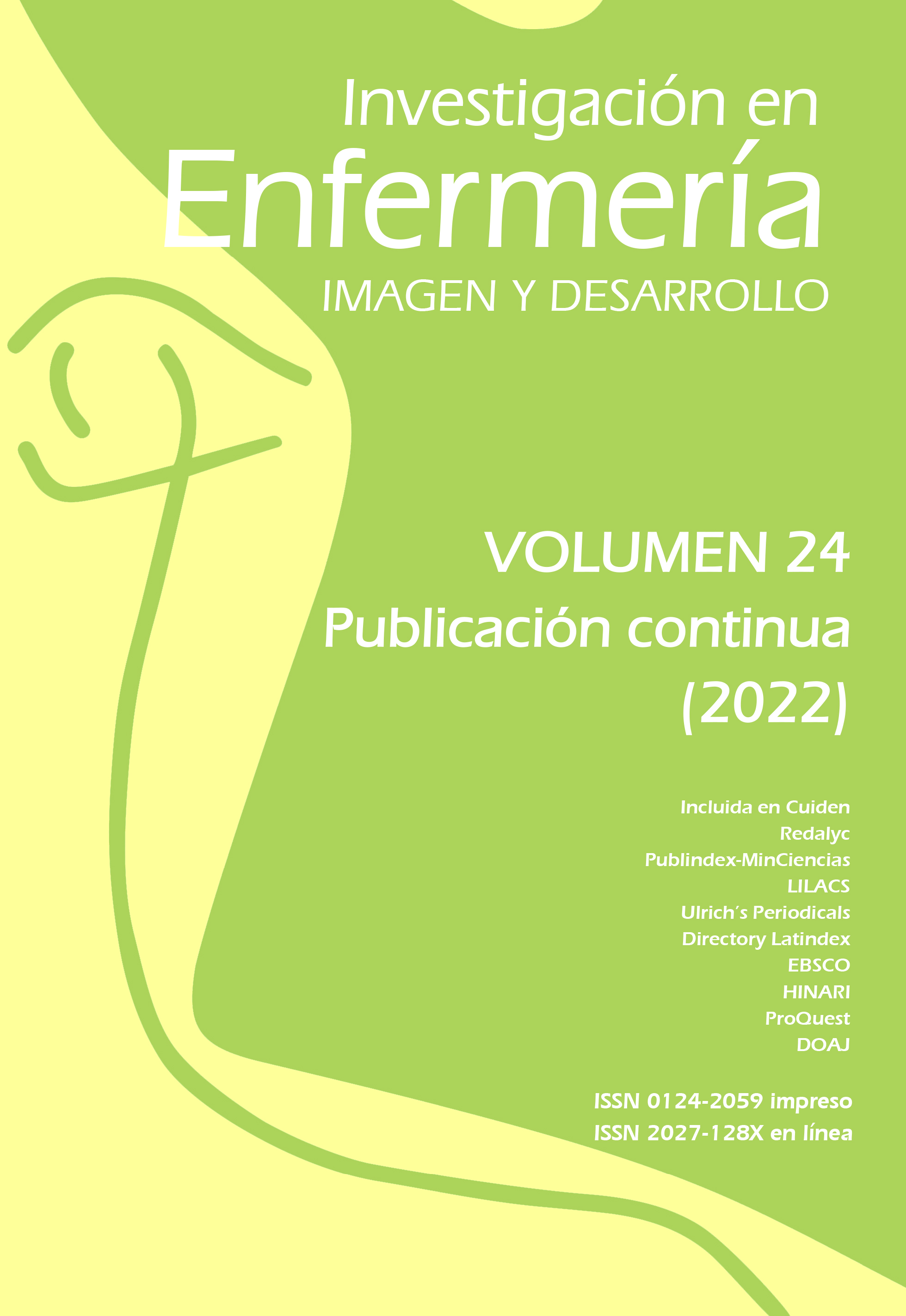Effect of a Nursing Discharge Plan to Improve Self-care in Patients with Heart Failure
##plugins.themes.bootstrap3.article.details##
Introduction: Heart failure (HF) is a disease with a high impact on people’s quality of life. Therefore, it is necessary to develop strategies that promote self-care from hospitalization and support the transition process. Objective: To determine the effect of a nursing discharge plan on the level of self-care of patients with HF who are hospitalized from January to November 2019. Methodology: Controlled clinical trial with a sample of 64 patients. They were randomized to discharge plan or usual follow-up. To measure the level of self-care, the European Self-Care Scale was used with a Cronbach’s alpha of 0.7. A descriptive analysis was performed with tables of frequencies and percentage distribution and the non-parametric Mann Whitney U test. Results: Before applying the discharge plan, it was determined that 90.2 % of the patients in the control and intervention groups had a low level of self-care. After applying the discharge plan, a statistically significant improvement (p: 0.000) was observed in the level of self-care. Conclusions: The discharge plan had a beneficial effect on the level of self-care thanks to its educational, motivational, behavioral reinforcement and symptom management components, allowing patients to assume an active role in modifying their behaviors to promote health.
plan, falla cardiaca, enfermería, autocuidadoplan, heart failure, nursing, self-care
2. Hsiao R, Greenberg B. Contemporary treatment of acute heart failure. Prog Cardiovasc Dis. 2016; 58:367-78. Available from: http://dx.doi.org/10.1016/j.pcad.2015.12.005.
3. Gómez E. Capítulo 2. Introducción, epidemiología de la falla cardiaca e historia de las clínicas de falla cardiaca en Colombia. Revista Colombiana de Cardiología. 2016;23(1): 6-12. Available from: http://dx.doi.org/10.1016/j.rccar.2016.01.004
4. Aragón D, Candelo R, Hurtado D, Meneces C, Muñoz S, Prado Y, et al. Evaluación del plan de alta por enfermería en el hospital San José, Popayán 2017. Rev. Med. Risaralda. 2020;26(1). Available from: https://doi.org/10.22517/25395203.20951
5. Riegel B, Dickson V, Faulkner K. The Situation-Specific Theory of Heart Failure Self-Care Revised and Updated. J Cardiovasc Nurs. 2016;31(3):226-35. Available from: 10.1097/JCN.0000000000000244
6. Navarro MD, Gálvez P, González L, Virumbrales M, Borrás A, Santesmases R, et al. Desarrollo de materiales educativos para pacientes crónicos y familiares. Revista educación médica, 2019;20(6):341-6. Available from: 10.1016/j.edumed.2018.03.020
7. Dávila FA, Mendoza FC, Boada NA, et al. Validación de la escala europea de autocuidado en la falla cardiaca. Rev Col de Cardiol. 2017; 24(2):105-9. Available from: https://doi.org/10.1016/j.rccar.2016.09.016
8. Campos A, Oliver A, Tomás J, Galiana L, Gutiérrez M. Autocuidado: Nueva evidencia sobre su medida en adultos mayores. Rev Esp Geriatr Gerontol. 2018;53(6):326-31. Available from: https://doi.org/10.1016/j.regg.2018.01.010.
9. Achury DM, Aponte LF, Gómez J, Roa N. Efecto del seguimiento telefónico en la adherencia al tratamiento en los pacientes con falla cardiaca. Enferm. glob. 2018;17(51). Available from: http://dx.doi.org/10.6018/eglobal.17.3.286281
10. Dunbar S, Clark P, Stamp K, Reilly C, Gary R, Higgins M, et al. Family partnership and education interventions to reduce dietary sodium by patients with heart failure differ by family functioning. Heart Lung. 2016;45(4):311-8. Available from: https://doi.org/10.1016/j.hrtlng.2016.04.001
11. Deek H, Noureddine S, Newton P, Inglis S, MacDonald P, Davidson P. A family focused intervention for heart failure self‐care: conceptual underpinnings of a culturally appropriate intervention. J Adv Nurs. 2016; 72(2):434-50. Available from: https://doi.org/10.1111/jan.12768
12. Domingo C, Aros F, Otxandategi A, Beistegui I, Besga A, Latorre P. Eficacia de un programa multidisciplinar de gestión de cuidados en pacientes que ingresan por insuficiencia cardiaca (ProMIC). Atención Primaria. 2019;51(3):142-52. Available from: https://doi.org/10.1016/j.aprim.2017.09.011
13. Michalik C, Matusik P, Nowak J, Chmielowska K, Tomaszewski K, Parnicka A, et al. Heart failure, comorbidities, and polypharmacy among elderly nursing home residents. Pol Arch Med Wewn. 2013;123(4). Available from: 10.20452/pamw.1682
14. Anguita M, Lambert J, Bover R, Comín J, Crespo M, González F, et al. Tipología y estándares de calidad de las unidades de insuficiencia cardiaca: consenso científico de la Sociedad Española de Cardiología. Revista Española de Cardiología. 2016;69(10):940-50. Available from: 10.1016/j.recesp.2016.06.010
15. Arredondo E, Rodríguez M, Higuita L. Dificultades con la adherencia al tratamiento no farmacológico de pacientes con falla cardiaca detectados a través de seguimiento telefónico. Investigación en Enfermería: Imagen y Desarrollo. 2014;16(2):133-47. Available from: https://doi.org/10.11144/Javeriana.IE16-2.dcat
16. Soto P, Masalan P, Barrios S. La educación en salud, un elemento central del cuidado de enfermería. The health education a central element of nursing care. Rev. med. clin. condes. 2018;29(3):288-300. Available from: https://doi.org/10.1016/j.rmclc.2018.05.001
17. Gregoria B, Melo M, Hernández Y, Carrillo GM, Alarcón DK. Efecto del programa Plan de egreso en pacientes crónicos y sus familiares cuidadores Enfermería Clínica. 2018;28(1):36-43. Available from: https://doi.org/10.1016/j.enfcli.2017.09.006
18. Rodríguez MJ, Capítulo 9. Transición del cuidado hospitalario al cuidado ambulatorio. Revista Colombiana de Cardiología. 2016; 23(1): 38-40. Available from: https://doi.org/10.1016/j.rccar.2016.01.011
19. Rivas E, López MA. Efectividad de las intervenciones educativas con enfoque multifactorial y seguimiento vía telefónica sobre la rehospitalización en pacientes con insuficiencia cardíaca: revisión sistemática y metaanálisis. Rev. méd. Chile. 2018;146(5). Available from: http://dx.doi.org/10.4067/s0034-98872018000500603
20. Mansouri A, Baraz S, Elahi N, Malehi A, Saberipour B. The effect of an educational program based on Roy’s adaptation model on the quality of life of patients suffering from heart failure: A clinical trial study. Jpn J Nurs Sci. 2019;16(4): 459-67. Available from: http://dx.doi.org/10.1111/jjns.12255

This work is licensed under a Creative Commons Attribution 4.0 International License.


